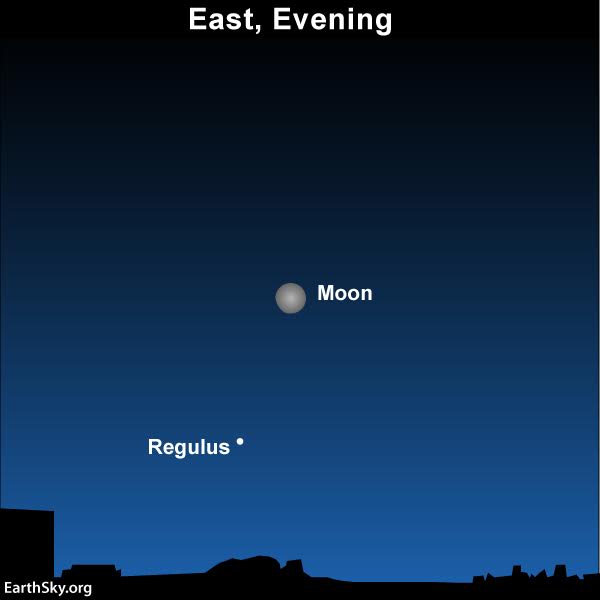How Many Years Pass Before a Blue Moons Happen

Looking for info on the January 31, 2018, lunar eclipse? Click here
Blue moons don't really look blue in color. Greg Hogan in Kathleen, Georgia, created the composite image at top of a Blue Moon (blue in name only!) on July 31, 2015. He wrote:
Having some fun with the blue moon idea……I blended the same image twice one with a blue tint, and one normal. :)
This year, 2018, we have two months (January and March) with Blue Moons. They are Blue Moons by the monthly definition of the term: the second of two full moons to fall within a single calendar month. The first Blue Moon comes on January 31, 2018, and the second on March 31, 2018. Meanwhile, the month of February 2018 has no full moon at all.
The precise instant of the January 31 Blue Moon is 13:27 UTC. Although the full moon happens at the same instant worldwide, the hour differs by time zone. At North American and U.S. times zones, that places the time of January 31 Blue Moon at:
9:27 a.m. AST
8:27 a.m. EST
7:27 a.m. CST
6:27 a.m. MST
5:27 a.m. PST
4:27 a.m. AKST
3:27 a.m. HST
The January 31, 2018, Blue Moon will undergo an eclipse. But – by the time that you read this post – the full moon instant and the total eclipse of the moon might already have passed. For more about the eclipse, go back to yesterday's sky post.
From the Americas, the moon that we see on the evening of January 31 is actually a waning gibbous moon, though it'll likely appear plenty full to the eye. That bright star near the January 31 moon is Regulus, the constellation Leo the Lion's sole 1st-magnitude star.

How often do we have a Blue Moon? If you're defining the Blue Moon as the second full moon of a calendar month, the answer is usually once every few years.
But – as is the case in 2018 – how often do we have two Blue Moons in a single year? For the answer, you have to look to a concept from astronomy and calendar studies, at what's called the Metonic cycle. The Metonic cycle is a period of 19 calendar years (235 lunar months), after which the new and full moons realign on or near the same dates of the year.
Therefore, 19 years from now, in 2037, we'll again have another Blue Moon in January and March.
There are 235 full moons (235 lunar months) yet only 228 calendar months in the 19-year Metonic cycle. Because the number of full moons outnumber the number of calendar months, that means at least seven of these 228 calendar months must harbor two full moons (235 – 228 = 7 extra full moons).
However, if a February within this 19-year period has no full moon at all – as is the case in February 2018 (and February 2037) – it's possible for an extra 8th full moon to fall into the lap of another calendar month. That's why the year 2018 (and 2037) have two Blue Moons, in January and March.
Let's take a look at the 8 Blue-Moon months in the upcoming 19-year Metonic cycle:
1. March 31, 2018
2. October 31, 2020
3. August 31, 2023
4. May 31, 2026
5. December 31, 2028
6. September 30, 2031
7. July 31, 2034
8. January 31, 2037
Moreover, the 19-year Metonic cycle assures us that seven of 19 years will also feature a seasonal Blue Moon – third of four full moons to occur in one season. Season is defined as the time period between a solstice and an equinox – or vice versa. The last Blue Moon by the seasonal definition happened on May 21, 2016. The next seven seasonal Blue Moons in the 19-year Metonic cycle:
1. May 18, 2019
2. August 22, 2021
3. August 19, 2024
4. May 20, 2027
5. August 24, 2029
6. August 21, 2032
7. May 22, 2035
In short, we have a monthly Blue Moon whenever we have 13 full moons in one calendar year, and a seasonal Blue Moon whenever we have 13 full moons in between successive December solstices.
This year, 2018, we have two Blue Moons because there are 13 full moons – plus a February with no full moon. In rare instances, it's possible for a year with only 12 full moons to have one Blue Moon – if February has no full moon at all (example: 2067).
Phases of the moon: 2001 to 2100 (Universal Time)
Solstices and Equinoxes: 2001 to 2100 (Universal Time)
Bottom line: The second of two January 2018 full moons falls today, on January 31, 2018. By popular acclaim, the second full moon to occur in a single calendar month is known as a Blue Moon. Thanks to what is called the Metonic cycle, 19 years from now, in 2037, we'll again have Blue Moons in January and March.
Donate: Your support means the world to us
Enjoying EarthSky so far? Sign up for our free daily newsletter today!
hodgkinsonforit1992.blogspot.com
Source: https://earthsky.org/sky-archive/blue-moon-on-january-31-2018/
0 Response to "How Many Years Pass Before a Blue Moons Happen"
Post a Comment